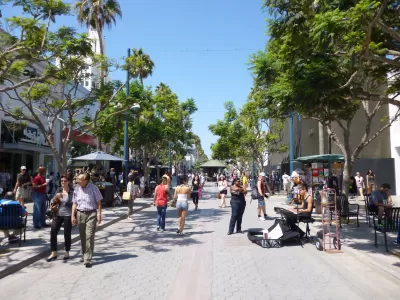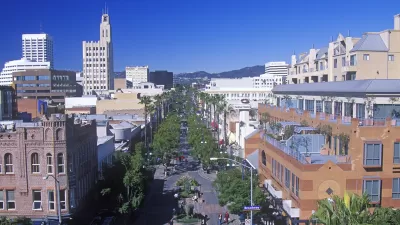Business owners in downtown Santa Monica have filed a lawsuit opposing the city's planned replacement of a parking structure with housing, despite city studies showing that the city's downtown parking supply far exceeds demand.

According to multiple studies commissioned by the city, Santa Monica owns far too many downtown parking spots, reports Aaron Gordon. With more people using ride-hailing apps and the recently opened Expo Line train, the beach city has roughly 2,000 excess parking spaces at any given time, even during peak hours.
Now, the city wants to convert one of its 13 downtown parking garages into affordable housing, a plan that housing advocates praise for its promise to build up to 150 housing units in the city's dense and transit-accessible downtown, replacing unnecessary parking with much-needed housing in one of the country's most expensive metropolitan areas.
Meanwhile, some business owners are protesting the proposal, arguing that the parking structure remains necessary to accommodate downtown residents, shoppers, and workers in spite of the city's studies. Gordon describes the opposition group's concerns about reduced sales tax and parking revenue, but reminds readers that "Many people enjoy downtown Santa Monica and it continues to be a popular upscale commercial and leisure destination." Urban growth experts, writes Gordon, say "the construction of mixed-use areas with both housing and stores that serve the needs of the people who live there" is key to promoting healthy economic development in downtown areas like the area surrounding Santa Monica's Third Street Promenade.
FULL STORY: Who Is Trying to ‘Save Parking Structure 3’ From Becoming Affordable Housing?

Planetizen Federal Action Tracker
A weekly monitor of how Trump’s orders and actions are impacting planners and planning in America.

Maui's Vacation Rental Debate Turns Ugly
Verbal attacks, misinformation campaigns and fistfights plague a high-stakes debate to convert thousands of vacation rentals into long-term housing.

San Francisco Suspends Traffic Calming Amidst Record Deaths
Citing “a challenging fiscal landscape,” the city will cease the program on the heels of 42 traffic deaths, including 24 pedestrians.

Defunct Pittsburgh Power Plant to Become Residential Tower
A decommissioned steam heat plant will be redeveloped into almost 100 affordable housing units.

Trump Prompts Restructuring of Transportation Research Board in “Unprecedented Overreach”
The TRB has eliminated more than half of its committees including those focused on climate, equity, and cities.

Amtrak Rolls Out New Orleans to Alabama “Mardi Gras” Train
The new service will operate morning and evening departures between Mobile and New Orleans.
Urban Design for Planners 1: Software Tools
This six-course series explores essential urban design concepts using open source software and equips planners with the tools they need to participate fully in the urban design process.
Planning for Universal Design
Learn the tools for implementing Universal Design in planning regulations.
Heyer Gruel & Associates PA
JM Goldson LLC
Custer County Colorado
City of Camden Redevelopment Agency
City of Astoria
Transportation Research & Education Center (TREC) at Portland State University
Jefferson Parish Government
Camden Redevelopment Agency
City of Claremont





























